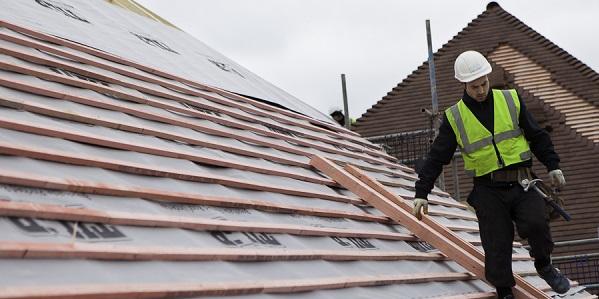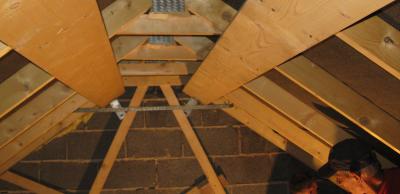Code of practice BS5534 spells changes for roofers
A new code of practice that details design standards, performance and installation of pitched roofs and vertical cladding using slates, tiles, shingles and shakes, as well as their associated components, has been published.
You have until February 2015 to start following the new standards outlined in the new BS5534 Code of Practice: Slating and tiling for pitched roofs and vertical cladding, which was published in August 2014 by the British Standards Institution.
Key changes that will affect you are
- Mortar alone cannot be used to fix ridges and hips. So, even if mortar is used, the ridges and hips must also be mechanically fixed
- Fixing requirements for roof tiles have been increased. All single-lapped tiles on a roof will now have to be mechanically fixed and perimeter tiles must now have a minimum of two fixings
- There will now be a single test for the measurement of the wind uplift resistance of underlays, which all testing bodies will have to comply with.
Ridges and hips - In future you are likely to be asked by building control bodies how you intend to meet these new requirements. Although you do not have to use dry fix systems, you will have to demonstrate how you can effectively fix ridge tiles when using mortar.
Fixing of roof tiles – This needs great care as there are a number of proprietary systems available, but beware as many of them are specific to particular makes of tiles. It will be up to you to demonstrate you have the correct fixings and numbers for the type of tiles you intend to use.
Roofing underlays – They are prone to stretching and ‘ballooning’ under wind load. This can cause the tiles to have greater wind loads applied to them than their design permits. The new standard for underlays will test against this issue. So be sure it has been tested to the new standard and clearly identified as being suitable for the site location and batten gauge in question.
The National Federation of Roofing Contractors (NFRC) is running a series of training courses to help you understand the implications of these changes. Contact Drew Beattie at NFRC for more information.
Sign up to the building bulletin newsletter
Over 48,000 construction professionals have already signed up for the LABC Building Bulletin.
Join them and receive useful tips, practical technical information and industry news by email once every 6 weeks.
Subscribe to the Building Bulletin




Comments
LABC Response
Submitted 1 year 1 month ago
Thank you for your enquiry.
This is more of a legal issue than a building control one so I would suggest you speak to a solicitor to discuss the best way to proceed.
Best,
LABC Team
Mortar bedding tiles at verge and valley
Submitted 3 years 6 months ago
(No subject)
Submitted 3 years 5 months ago
Best,
LABC team
Roof Tile Issue
Submitted 3 years 1 month ago
LABC response
Submitted 3 years ago
Thank you for your recent enquiry and I am sorry to hear of the problems with your new house and the roof tiles. As you have outlined you have contacted the builders, the warranty provider, and your insurers and therefore I can only advise that as the responsibility for compliance rests with the builder that you continue the dialogue with them.
Best,
LABC team
Gable end Tiles
Submitted 2 years 11 months ago
I had a roofer to put me one in, but he noticed that just about none of the gable end Tiles were secured, not even nailed in, the wood laths are not wide enough.
I've been InTouch with the builder's they won't assit because of the age of the house, NHBC won't do anything because there's no water damage in the house, he also noticed two velux windows are not fitted properly as well,. Who should be liable for this, any suggestions would be grateful
LABC response
Submitted 2 years 10 months ago
Thank you for your recent enquiry regarding the issues with the roof at your home.
LABC is a membership organisation, providing advice and support to its member local authorities around England and Wales, therefore we are unable to give advice on any particular situation and are not able to comment on disputes.
Liability in respect of compliance or non-compliance with the building regulations is a complicated matter, we suggest that you may wish to take some legal advice on this matter, and it might be an area where Citizens Advice could help initially.
We are sorry we cannot be of further assistance and hope you manage to resolve the matter satisfactorily.
Best,
LABC team
NEW SLATE ROOF
Submitted 2 years 10 months ago
LABC response
Submitted 2 years 10 months ago
The use of copper nails for fixing slates to a roof is not mandatory. However, the use of copper fixings is recommended in corrosive or marine atmospheres, which may apply at Watchet. Further advice can be found at Natural Slate: Hook or Nail Fixing? | SIGA : SIGA (sigaslate.co.uk). (http://www.sigaslate.co.uk/knowledgebase/design-guidance/natural-slate-hook-or-nail-fixing/).
We do not take responsibility for the content and accuracy of any links provided and their provision should not be taken as endorsement of any organisation or guidance. Links to external sources are provided to signpost other sources of information and should not be considered as any form of legal advice.
Best,
LABC team
Implementation and compliance dates
Submitted 2 years 10 months ago
One question I have is around the dates of complying.
Is it based on planning approval or is based on build date itself? And is this down specific / individual dwellings or based on an entire development (multiple properties)?
I.e if planning was approved in 2014 but build of specific house occurred on or after February 2015, would BS5534 be the required build standard?
Thanks
Add new comment